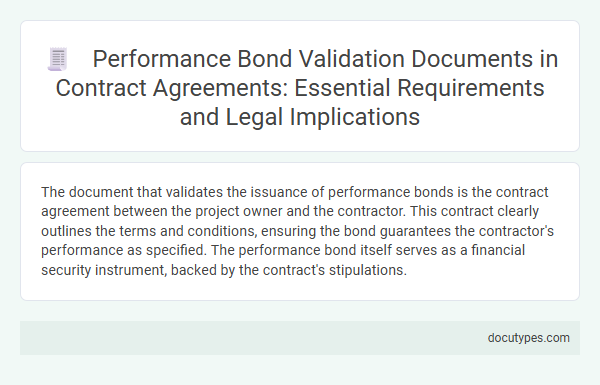The document that validates the issuance of performance bonds is the contract agreement between the project owner and the contractor. This contract clearly outlines the terms and conditions, ensuring the bond guarantees the contractor's performance as specified. The performance bond itself serves as a financial security instrument, backed by the contract's stipulations.
Introduction to Performance Bond Validation in Contract Agreements
Performance bonds are critical financial instruments in contract agreements, ensuring project completion and compliance. Validation of these bonds is essential to guarantee the obligations are legally supported and enforceable.
- Surety Bond Document - This official agreement between the principal, obligee, and surety verifies the issuance and terms of the performance bond.
- Contract Agreement - The primary contract references the requirement and conditions for the performance bond, linking it directly to project obligations.
- Bond Certificate - A formal certificate issued by the surety company serves as proof that the performance bond has been issued and is active.
Key Components of Performance Bond Documentation
The document that validates the issuance of performance bonds is the performance bond agreement, which is a legally binding contract between the obligee, the principal, and the surety. Key components of performance bond documentation include the bond amount, the scope of work covered, the conditions triggering bond claims, and the responsibilities of each party involved. Proper documentation also outlines the duration of the bond, claim procedures, and remedies available should the principal fail to fulfill contractual obligations.
Legal Framework Governing Performance Bonds
The issuance of performance bonds is validated through specific legal documents that establish the bond's terms and obligations. These documents operate within a legal framework designed to protect project stakeholders and ensure contract fulfillment.
- Performance Bond Agreement - This primary document outlines the obligations of the bond issuer, contractor, and obligee, detailing the conditions under which the bond is issued and enforced.
- Surety Bond Form - A standardized form used by surety companies that legally binds the surety to cover the contractor's performance obligations if necessary.
- Contractual Provisions - Contract clauses incorporated by reference or explicitly stated in the construction or service contract that mandate the requirement and parameters of the performance bond.
Essential Requirements for Valid Performance Bonds
The document that validates the issuance of performance bonds is the bond agreement itself, which serves as a legal contract between the principal, the obligee, and the surety. It outlines the obligations and responsibilities of each party, ensuring the guarantee of contract performance.
Essential requirements for valid performance bonds include a clear description of the bonded contract, the bond amount, and the conditions under which the bond can be claimed. Your performance bond must also be signed by an authorized representative of the surety company and comply with local laws and regulations to be enforceable.
Common Types of Performance Bond Validation Documents
Performance bonds ensure the completion of contractual obligations, providing financial security to the project owner. Various documents validate the issuance of these bonds, confirming their authenticity and enforceability.
Common types of performance bond validation documents include the original bond certificate, which serves as proof issued by the surety company. The contract agreement between the parties often references the bond requirements, linking the bond to specific project terms. Your review of these documents guarantees that the bond meets all contractual and legal criteria for protection.
Verification Procedures for Performance Bond Authenticity
The issuance of performance bonds is validated through specific documentation that confirms the bond's authenticity and enforceability. Verification procedures ensure the bond complies with contractual and legal standards before acceptance.
- Performance Bond Certificate - This official document issued by the surety company serves as primary proof of the bond's validity.
- Surety Company Verification - Contacting the surety company directly confirms the bond's issuance and coverage details.
- Contractual Agreement Cross-Check - Reviewing the bond against contract terms ensures alignment with project requirements and obligations.
Proper verification of performance bonds protects all parties by confirming financial backing and commitment fulfillment.
Legal Rights and Obligations of Parties Involved
What document validates the issuance of performance bonds? The performance bond certificate serves as the official legal document confirming the bond's issuance. It establishes the rights and obligations of the principal, obligee, and surety involved in the contract.
Common Pitfalls in Performance Bond Documentation
| Document Validating Issuance of Performance Bonds | The primary document that validates the issuance of performance bonds is the Performance Bond Certificate. This certificate is evidence issued by a surety company guaranteeing that the contractor will fulfill their contractual obligations. It details the bond amount, obligee, principal, and the terms under which the bond is valid. |
|---|---|
| Common Pitfalls in Performance Bond Documentation |
|
The Impact of Invalid Performance Bonds on Contracts
The document that validates the issuance of performance bonds is the bond certificate or the surety bond agreement, which outlines the terms and guarantees provided by the surety company. This document serves as proof that the bond is legally binding and enforceable, protecting the interests of the project owner and contractor.
Invalid performance bonds can severely impact contracts by creating uncertainty and risking financial losses if the bond fails to provide the promised protection. You may face delays, legal disputes, or lack of compensation in cases of contractor default, undermining the contract's security and reliability.
What Document Validates the Issuance of Performance Bonds? Infographic

